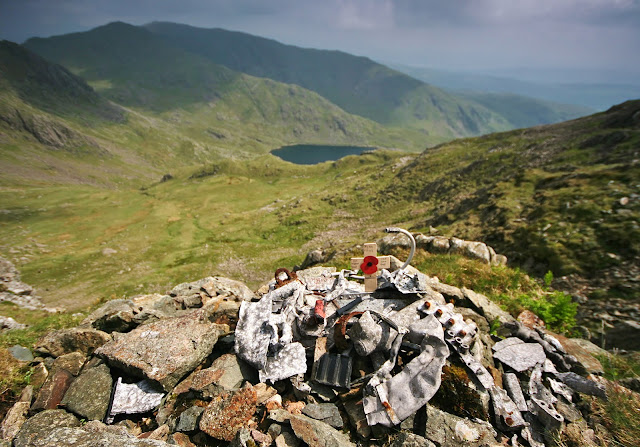An unusual last journey for this aircraft and crew began in Morrisfield, Florida before continuing on its exotic way through Trinidad ,Brazil , Dakar, Marrakech,before finally landing at RAF St. Mawgan in Cornwall. The last section of the journey was to Burtonwood in Lancashire . They set off from St. Mawgan at 12.38 for the final short leg on the 1st. February 1945 . They were destined to never arrive at Burtonwood .
Low cloud and high winds resulted in them going off course and flying at just over 3000 feet they decided to either land not realising they were off course or to attempt to get a fix by dropping beneath the clouds . Perhaps unaware of the dangers of flying in the UK in cloud they descended straight into the near summit of Y Garn in the Snowdonia mountain range Wales.
The aircraft broke in two on impact the front section hurtling over the ridge and down into Cwm Cywion . One crew member lay dead near the summit the other four remained in the wreckage that went down into the Cwm . Eyewitness accounts of the scene state that they could not have survived the intial impact .
It was another two days before the bodies were recovered from the snow covered mountain.
The crew of 5 were
2ndLt. Kenneth W.Carty Pilot
2ndLt William H. Cardwell Co-pilot
1stLt. Nolen B. Sowell Nav.
Cpl. Jack D. Arnold Rad. Op.
Cpl. Rudolph M . Aguirre Eng.
All were from States across America .
Up to the 60's and 70's much wreckage remained but since then 'enthusiasts ' have removed it .....very little remains now at the summit , we found small pieces of alloy from an engine cylinder casing and a few shards of glass there. More is to be found in the Cwm and on the scree but even then it amounts to very little .
A tragic event , the crewmen never really had a chance to aclimatise themselves to the weather over the UK which claimed a very many lives during the war .
An undercarriage leg in a stream is pictured above.
 |
| Ian stood on the impact point |

















































